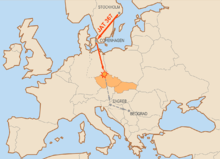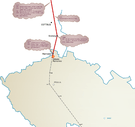JAT Flight 367
 | |
| Bombing summary | |
|---|---|
| Date | 26 January 1972 |
| Summary | Bombing |
| Site | Srbská Kamenice, Czechoslovakia |
| Passengers | 23 |
| Crew | 5 |
| Fatalities | 27 |
| Injuries (non-fatal) | 1 (Vesna Vulović) |
| Survivors | 1 flight attendant (Vesna Vulović) |
| Aircraft type | McDonnell Douglas DC-9-32 |
| Operator | JAT Yugoslav Airlines |
| Registration | YU-AHT |
| Flight origin |
Stockholm-Arlanda Airport Stockholm, Sweden |
| Stopover |
Copenhagen Airport Copenhagen, Denmark |
| Last stopover |
Zagreb Airport Zagreb, Yugoslavia |
| Destination |
Belgrade Airport Belgrade, Yugoslavia |
.jpg)
JAT Yugoslav Airlines Flight 367 was a McDonnell Douglas DC-9-32 aircraft (registration YU-AHT) which exploded shortly after overflying NDB Hermsdorf, East Germany, while en route from Stockholm to Belgrade on 26 January 1972. The aircraft, piloted by captain Ludvik Razdrih, broke into two pieces and spun out of control, crashing near the village of Srbská Kamenice in Czechoslovakia (now the Czech Republic). Of the 28 on board, 27 were killed upon ground impact; but one Serbian crew member, Vesna Vulović, survived.[1]
Cause

The McDonnell Douglas DC-9-32 was destroyed in flight by émigré Croatian terrorists who had placed a bomb on board. Vesna Vulović was near the rear of the aircraft at the time of the explosion but this is disputed. A food cart pinned her to the back of the plane during her fall, acting as a seat belt, thus preventing her from being sucked out of the plane during de-compression or the ensuing fall. Some reports stated she was at the back when the explosion occurred, but she has said she was told that she was found in the middle section of the plane.[2]
Vulović was in a coma for 27 days and was temporarily paralyzed from the waist down, but survived.[3] She continued working for the airline, holding a desk job.[4]
In popular culture
Vesna Vulović holds the official record in the Guinness Book of Records for the highest fall survived without a parachute.[2] Vulović received the Guinness prize from Paul McCartney.[2]
A major celebrity in the Socialist Federal Republic of Yugoslavia, Vesna Vulović was a frequent guest on major Yugoslav TV shows such as Maksovizija by Milovan Ilić Minimaks, up until the 1990s. Vulović attended annual commemorations at the crash site, until they were stopped in 2002. The daughter of the firefighter that saved her bears her name, as well as a local hotel in the Czech Republic, near the site of the crash.
The plane crash was a subject of MythBusters. Episode 37, "Escape Slide Parachute (Story of Vesna Vulović)" was devoted to her case.[5] The MythBusters concluded it was possible to survive the fall depending on how the wreckage someone was sitting in landed. Discovery Channel in their programme Against all Odds also profiled Vulović's fall to earth.
Conspiracy theories
The officially stated cause of the crash was challenged occasionally over the years by conspiracy theories. For example, in 1997 the Czech periodical Letectví a kosmonautika reported that the plane was shot down by mistake by Czechoslovak air defense.[6]
Shot down theory
The discussion about different aspects of the crash was reopened on 8 January 2009, when German news magazine Tagesschau featured a report by investigative journalists Peter Hornung and Pavel Theiner.[7][8] Allegedly based on newly obtained documents mainly from the Czech Civil Aviation Authority, they concluded that it was "extremely likely" that the plane had been mistakenly shot down only a few hundred meters above the ground by a MiG fighter of the Czechoslovak Air Force, having been mistaken for an enemy aircraft while attempting a forced landing.[4][9] All the evidence suggesting that the plane was destroyed at high altitude by explosives placed in a suitcase would be therefore forged by Czechoslovak secret police.
As evidence that the DC-9 had broken up at a lower altitude, the journalists cited eyewitnesses from Srbská Kamenice, who had seen the plane burning but still intact below the low-hanging clouds, and confirmation of a Serbian aviation expert (who had been present at the crash site) that the debris area had been much too small for a crash from high altitude; it also referred to sightings of a second plane.[4][8] According to Hornung, flight 367 got into difficulties, "went into a steep descent and found itself over a sensitive military area", close to a nuclear weapons facility.[4] However, Hornung himself stated that for his theory "there are only indications, no evidences".[7][8]
Reactions
Vesna Vulović (who has no memory of the crash or the flight after boarding[4]) referred to the claims that the plane attempted a forced landing or descended to such low altitude as a "nebulous nonsense".[10] A representative of Guinness World Records stated that "it seems that at the time Guinness was duped by this swindle just like the rest of the media."[4]
The Czech Civilian Aviation Authority dismissed the conspiracy theory as media speculation, that appears from time to time. Its spokeswoman added that Authority experts would not comment on them[11] and that findings of the official investigation are being questioned mostly because of the media attractiveness of the story.[12]
The Czech magazine Technet quoted a Czech army expert: "In case of violation of the air space, the incident would not be solved by anti-air missiles, but by fighter planes. Also it would not be possible to conceal such incident, as there would approximately 150–200 people knowing about the incident. They would not have any reason to not tell about incident today." A potential missile launch would be audible and especially visible for thousands people long after release. He further claims that for the Yugoslavian plane it was technically impossible to dive in a "state of emergency" from the proven flight level to the low altitude and place where it was allegedly shot down. He also states that the debris area wasn't "too small" but that the main parts were more than 1,5 km apart.[13][14]
Additionally, the Czechoslovak Air Defense soldier who operated the radar that very day stated in a 2009 interview that any Czechoslovak jet fighters would be noticed by the West German Air Defense.[12]
The main argument against such a theory is the flight data obtained from the black box, which provided the exact data about the time, speed, direction, acceleration and altitude of the plane at the moment of the explosion. Both black boxes were opened and analysed by the service companies in Amsterdam in the presence of experts from Czechoslovakia, Yugoslavia and the Dutch Aviation Office (Raad voor de Luchtvaart).[15]
See also
- List of accidents and incidents involving airliners by airline
- List of sole survivors of airline accidents or incidents
- Nicholas Alkemade (RAF gunner who survived a fall of 18,000 feet)
- Vesna Vulović
References
- ↑ Official abstract of final report (english) (Archive)
- 1 2 3 "Interview with Vesna Vulovic". avsec.com. April 2002. Retrieved 11 March 2013.
- ↑ "ACCIDENT DETAILS". planecrashinfo.com. Retrieved 11 March 2013.
- 1 2 3 4 5 6 Kate Connolly: Woman who fell to earth: was air crash survivor's record just propaganda? The Guardian, 13 January 2009
- ↑ Tv.Com – Mythbusters: Escape Slide Parachute (Story of Vesna Vulović)
- ↑ Šírová, Tereza. "Teroristický útok nad ČSSR přežila jen letuška, padala z 10 km". Technet.cz. Retrieved 22 February 2015.
- 1 2 BIENE, JANUSZ (9 January 2009). "Geheimdienst erfand Bombenattentat". die Tageszeitung. Retrieved 11 March 2013.
- 1 2 3 Tagesschau.de Jan 8, 2009; Geheimdienst erfand Rekord: Vom Himmel gefallen – das Wunder der Vesna Vulovic Archived 2 February 2010 at the Wayback Machine.
- ↑ Ben Leach: Serbian flight attendant's fall from 10,000 metres was 'hoax' The Daily Telegraph, 14 January 2009
- ↑ 'Nismo letjeli na stotinjak metara'
- ↑ ČTK. "Yugoslav plane was probably shot down in 1972 by Czechs - ARD". České noviny.cz. Archived from the original on 17 December 2014. Retrieved 22 February 2015.
- 1 2 Downing of a Yugoslav aircraft by Czechs could not be hushed up, witness from the radar says
- ↑ Only air hostess survived terrorist attack above CSSR, she felt from 10 kilometers
- ↑ Šírová, Tereza. "Sestřelení civilního letadla armádou? Popírá to fyziku, říká odborník". Technet.cz. Retrieved 22 February 2015.
- ↑ "Souhrnná zpráva Státní letecké inspekce o šetření příčin letecké nehody (NA, ÚCL, karton 84, sg. 2/1972)". National Archives (Czech Republic). Retrieved 22 February 2015.
External links
| Wikimedia Commons has media related to Yugoslav Airlines flight 367. |
- (Czech) Accident to Yugislav aircraft YU-AHT on January 26, 1972 in Czech Kamenica. The blast from explosives in carry-on luggage in the front luggage compartment caused the plane crash of DC-9-30 Yugoslav Airlines flight JU 367 Stockholm - Copenhagen - Zagreb - Belgrade (Archive, PDF format, Archive)
- (Czech) Summary Report of the State Aviation Investigation Inspectorate of the causes of the accident (NA, ÚCL, karton 84, sg. 2/1972)] (Archive)
- English summary: Analysis and conclusions (Archive) - English extract from the summary report to the International Civil Aviation Organization (NA, ÚCL, karton 83, sg. 2/1972)
- (Czech) Draft interim report - the airspace at the time of the accident: report and radar images (NA, ÚCL, karton 83, sg. 2/1972) (Archive)
- Photos of radar screen at ATC Cottbus (East Germany) (Archive)
- (Czech) Situační plán havárie letadla 1:10 000, příloha dokumentace o ohledání osobních věcí obětí. Federální ministerstvo vnitra, Odbor vyšetřování StB Ústí nad Labem (NA, ÚCL, karton 83, sg. 2/1972) (Archive)
- Airliners.Net: Picture of YU-AHT
- Entry on Flight 367 at PlaneCrashInfo.Com
- Criminal Occurrence description at the Aviation Safety Network
- JAT 367 Memorial
Coordinates: 50°49′37″N 14°20′47″E / 50.82694°N 14.34639°E